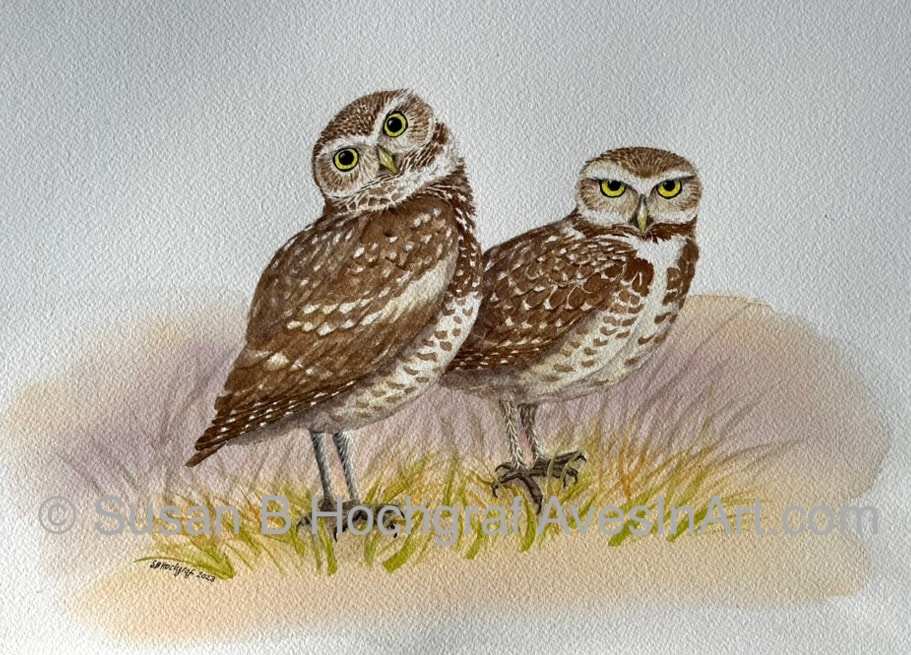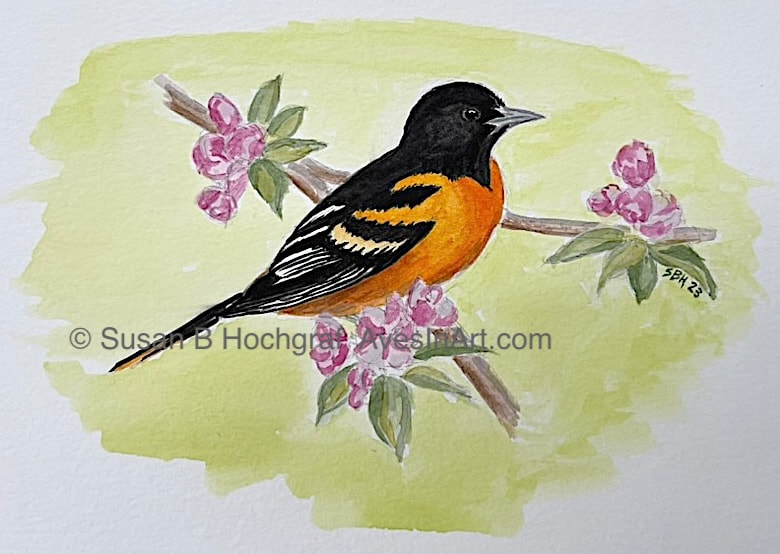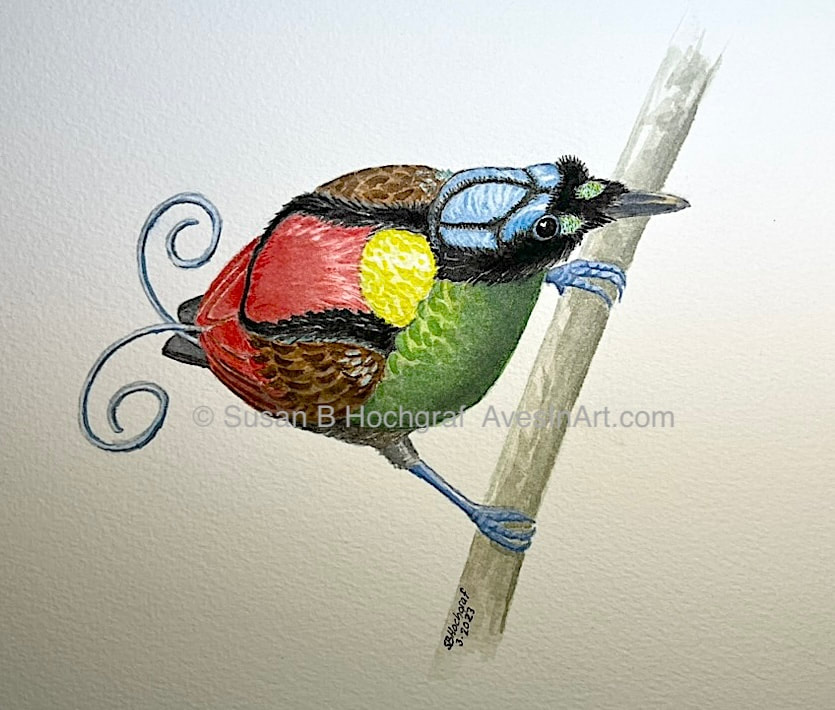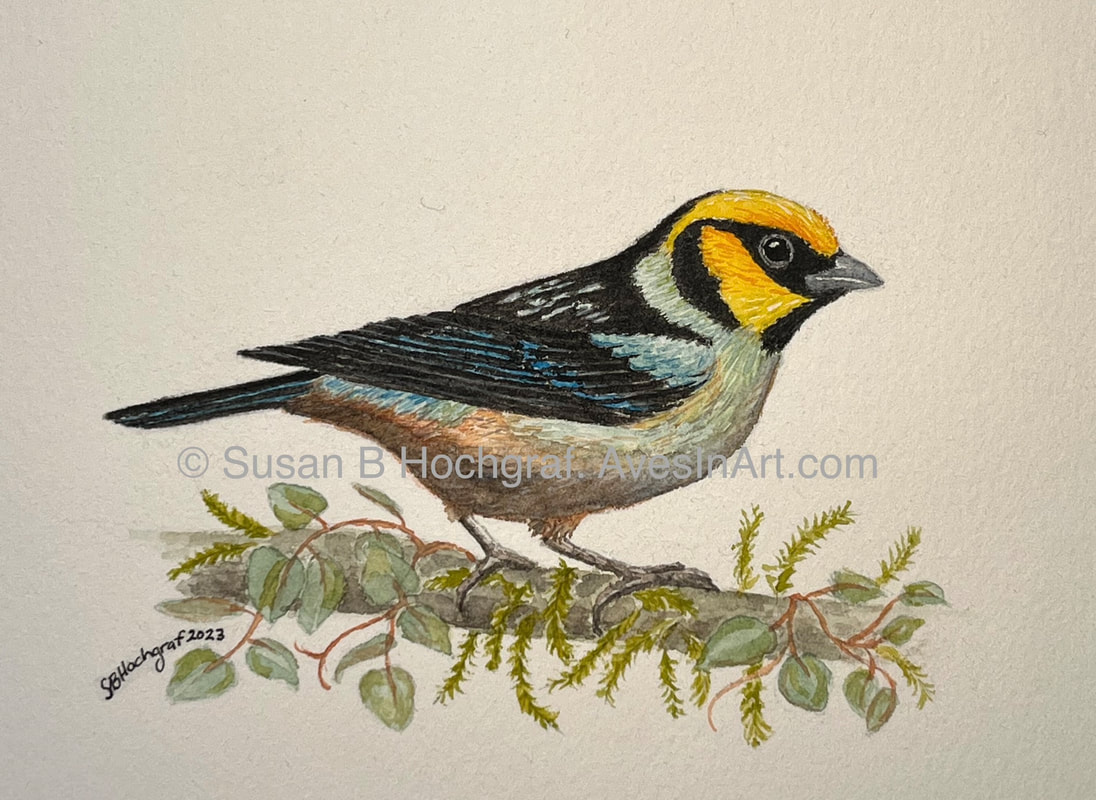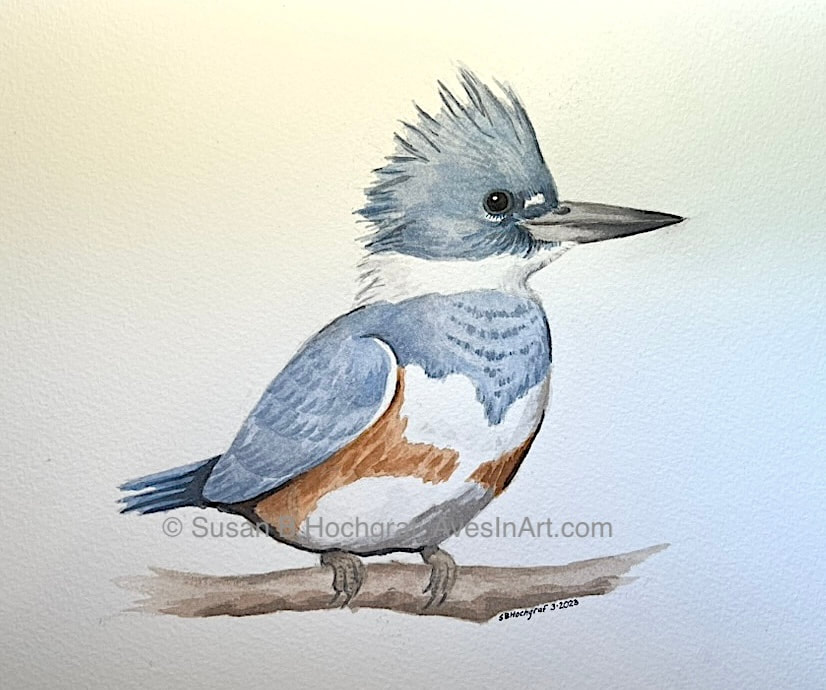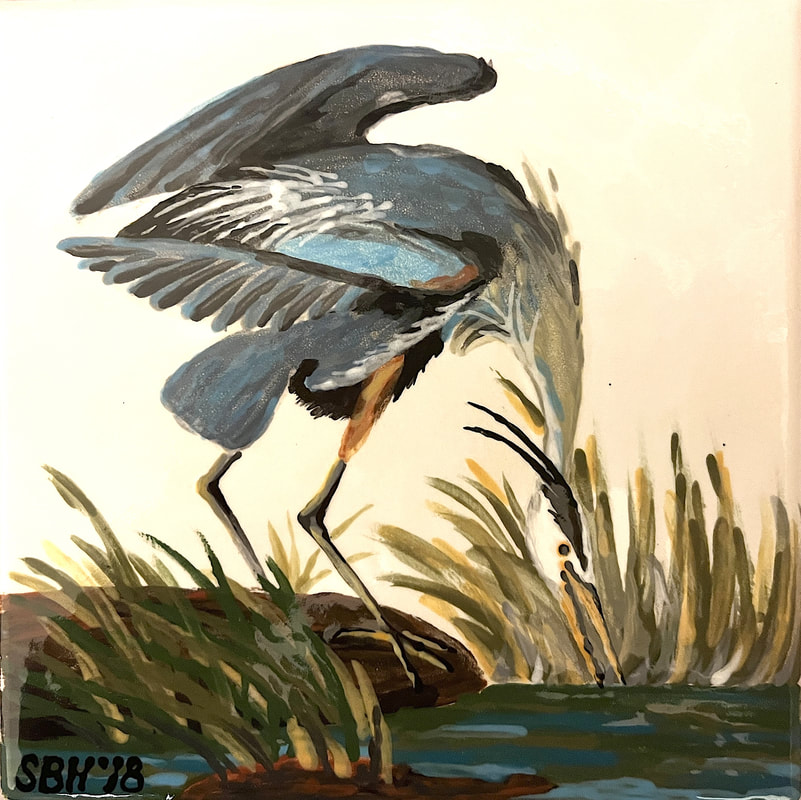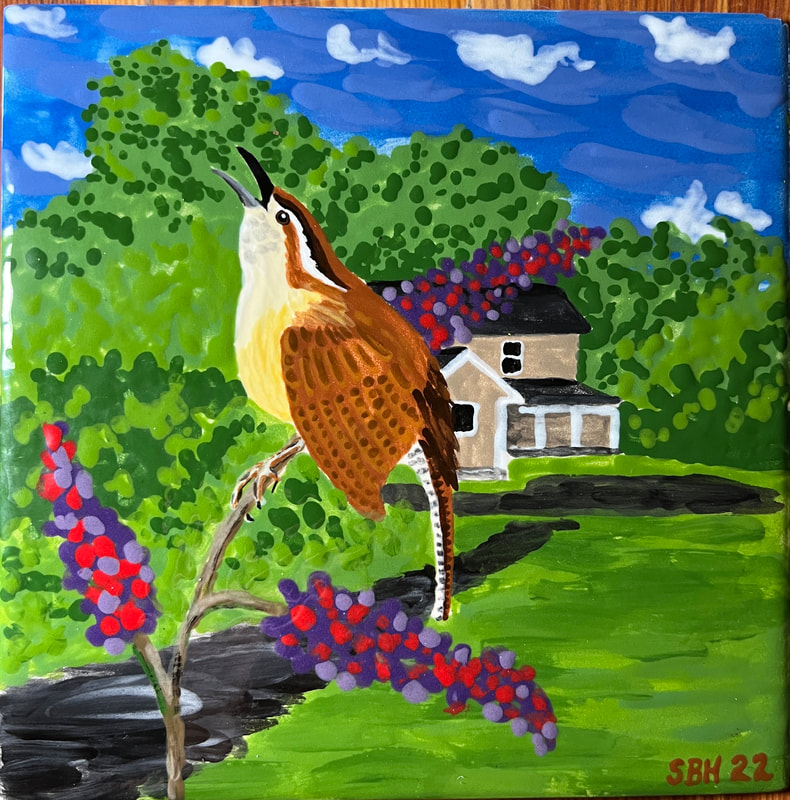Drawings and Paintings
A sampling of recent drawings and paintings. Descriptions give the medium, inspiration, and other notes. Watercolor, acrylic, graphic design, ceramic tile, colored pencil - it's all here. These pieces were all done by request or for a particular project or exhibition. If you'd like to commission something in particular, contact me by email - info at avesinart dot com (we get spam, hence the long-hand).
Recently I've been experimenting with vector-based drawing. It started with the Red-breasted Merganser, which won a design competition for the Maryland Ornithological Society's 2024 convention.
Painted Bunting (Passerina ciris)
Acrylic on Canson 140# cold-pressed paper, 25 x 17cm
Acrylic on Canson 140# cold-pressed paper, 25 x 17cm
|
Many years ago I saw a mockingbird perched on a neighborhood street sign - and sketched the scene. I would occasionally think - there's an opportunity there - so my sister asked for this combination of birds and sign.
The plumage of the male Painted Bunting is mind-blowing! Gold shading to green, green shading to red, scarlet shading to rose. The female has her own understated pizzazz in that coat of bright olive and lemon yellow-green. |
|
Laughing Kookaburra (Dacelo novaeguineae)
Watercolor on Arches 140# cold-pressed paper, 41 x 31cm |
After spending time in Australia, I wanted to paint an iconic bird from our trip. Although many are more colorful and many are more unique, there is none so evocative of that continent as the Laughing Kookaburra.
I've shown it perched on a River Red Gum (Eucalyptus camaldulensis). A mature River Red Gum has fantastically colorful bark that peels away in strips. Eucalypts come in all shapes, sizes and habitat requirements - from shrubby desert plants to massive forest giants. |
The elongate blue-green leaves are familiar to many outside of Australia because species such as the Blue Gum (Eucalyptus globulus) have been introduced around the world.
|
|
Burrowing Owl (Athene cunicularia)
Watercolor on Arches 140# cold-pressed paper, 41 x 31cm |
Athena, the goddess of wisdom and patron goddess of the alma mater of my younger daughter, was closely associated with the Little Owl (Athene noctua). Athens, Athena, Athene, Greece, it's where it all began (just ask any Greek!). There are nine species in the genus Athene, this is the only one found in the Americas, from Canada to southern Argentina.
This Burrowing Owl duo stands atop their grassy mound watching out for prey - and predators. The head tilt is a specific motion (parallaxing) that enables the bird to better determine the position of something relative to the background. A more commonly observed form of parallaxing is a simple head-bob, often seen just before a raptor takes flight towards its prey. |
|
Baltimore Oriole (Icterus galbula)
Watercolor on Canson 140# cold-pressed paper, 25 x 17cm |
A birthday sketch for my neighbor who enjoys the annual return of neotropical migrants. In our neighborhood, the oriole arrives just as the apple blossoms open, from late April to early May.
Have time for a digression? I love the story of the naming of this bird. By 1669, English settlers to the colony that became the US state of Maryland were calling it the Baltimore Bird, named for their colonial governor, Lord Baltimore, whose heraldic colors were golden-orange and black. Next we find Mark Catesby, a young Englishman and one of the first naturalist/artists of the American colonies, who included this bird in his work The Natural History of Carolina, Florida and the Bahama Islands, published in 1731. Catesby called it Icterus, the Baltimore Bird. The Swedish taxonomist Carl Linnaeus very likely got his hands on Catesby's book and used that description in his Systema Naturae (10th edition, 1758), but changed the name to Baltimore Oriole because he (old Carl) was familiar with the European orioles that look similar - but Catesby was right! It's an Icterus, of the American family of blackbirds. |
|
Wilson's Bird-of-Paradise (Diphyllodes respublica)
Watercolor on Canson 140# cold-pressed paper, 25 x 17cm |
How many times have we watched David Attenborough traipse through the rainforests of New Guinea, narrating yet another quest for the BBC? Who hasn't dreamed of someday observing these birds-of-paradise for themselves? As a lifelong naturalist and dreamer, Jorge was determined to make this trip happen and to photograph some of these beauties. On Waigeo Island, a 3-hour boat ride off the west coast of West Papua, Indonesia, he at last spent time with his first, the Wilson's Bird-of-Paradise.
The darkness of the forest before dawn and the prohibitions against using flash make photography a challenge, but anyone who gets that far, well, they know what they're doing! With paintbrush and lighter shades of color, I pulled out details of the feathers, the light blue bare skin, the green scaled breast - endless details that make these birds so fascinating. When the male displays to the female (who watches from above on the same stem) he spreads the green feathers into a disc shape, flares the yellow and red feathers of the mantle (upper back), opens his bill revealing a neon-green mouth lining and dances about the vertical branch. |
|
Flame-faced Tanager (Tangara parzudakii)
Watercolor on Canson 140# cold-pressed paper, 25 x 17cm |
My sister had just returned from a birding trip to Ecuador and was a little disappointed with her photograph of this species. I spiffed it up a little for her - I mean, how often does a branch or leaf conceal part of the bird? My artistic license is always handy, to clear away those stray twigs.
A tanager of the mid-elevation Andes, from Columbia into Peru, this species exhibits strong color variation from west to east. This western form shows a yellow face while the eastern form has a bright red face. |
|
Belted Kingfisher (Megaceryle alcyon)
Watercolor on Canson 140# cold-pressed paper, 25 x 17cm |
This is the painting that jump-started my latest watercolor phase. She was the 2023 Bird of the Year for the American Birding Association (ABA). I signed up for a 2-hour online class with Liz Clayton Fuller, through the Cornell Lab of Ornithology. She took us step by step through the basics of building up washes, laying in shadows, defining the eye. Liz masterfully guided an unseen classroom full of bird-artist wannabees to creating our personal painting of the female Belted Kingfisher.
|
|
Back Porch Garden
Acrylic on canvas board, 45 x 35 cm |
The colors and textures of late summer in my backyard garden, as seen from the shade of the porch. I've exaggerated both color and texture, playing on a lesson from high school art class, where we sat outside and painted fallen pine needles bright orange and tree shadows deep purple.
The Blue Jay perched atop the feeders was the final detail added to the composition. |
|
Carolina Wren (after John James Audubon)
Glazed ceramic tile, 6" |
Audubon posed his Great Carolina Wren (Thryothorus ludovicianus) on top of a panicle of red flowers of the Dwarf Buckeye (Aesculus pavia). I have used the same pose, but placed mine on a branch of butterfly bush with our house and gardens in the background.
|
|
Northern Saw-whet Owl (Aegolius acadicus)
Acrylic on canvas board, 18 x 27 cm |
Nocturnal owls roost in a concealed location during the day. The tiny Saw Whet Owl usually chooses dense conifers for a day-time roost.
A sighting of this owl is uncommon, and in fact the species was thought to be rare until a recent mist-netting study revealed that they are actually quite common - just not often observed. |
|
Black-capped Chickadee (Poecile atricapillus)
Acrylic on canvas board, 25 x 20 cm Small birds fluff their feathers to trap body heat on cold days, which is also when these chickadees appreciate energy-rich sunflower seeds from backyard feeders. The colder it is outside, the tighter the curl of the rhododendron leaves. |
|
Jocotoco Antpitta (Grallaria ridgelyi)
Acrylic on canvas board. Left: 25 x 20 cm, Right: 20 x 20 cm The pattern of color, of light and dark on this antpitta's face is unique in the genus Grallaria. Although this bird, like all passerine birds, has very limited forward-facing vision, I have shown it in this view to capture the striking pattern of dark and light feathers. This bird was new to science in 1997, discovered in the Andes of southern Ecuador. |
|
Green Jay (Cyanocorax luxuosus)
Acrylic on canvas board Right: 20 x 20 cm, Left: 25 x 20 cm The Green Jay is a bird of subtropical to tropical forests, where sun-dappled shade is common. These colors and patterns work well to confuse and conceal the bird's actual features. The pale blue feathers above and below the eye stand out from the black mask, and can be articulated separately from the other facial feathers. |
|
Common Potoo, Urutaú (Nyctibius griseus)
Watercolor and gouache. 38 x 56 cm |
In the family Nyctibiidae and order Caprimulgiformes, Potoos are a South and Central American bird, closely related to Whippoorwills. Many members of this large group camouflage on the ground, in leaf litter, or by aligning the body parallel to a tree limb. The Common Potoo hides in plain sight, often perching on the exposed end of a broken branch. A nocturnal flier, the potoo will remain motionless during the day, keeping watch on the observer through specially notched eyelids. The chick learns to "freeze" at a very young age, but here has been caught peeking. As they rest together, the silky breast feathers of the parent bird drape over the youngster, blending the two into one.
This painting was exhibited in the Greater New York Guild of Natural Science Illustrator's 2013-2014 show, with the theme of Nature's Camouflage. From April through September 2014, my potoos were also in the Guild's National Member's Show in Boulder, Colorado. Here's my blog post about the GNSI annual meeting in general. |
|
Black and White Monjita,
Viudita Blanca Grande (Xolmis dominicanus) Watercolor and Gouache, 28 x 38 cm |
In the family Tyrannidae, this striking flycatcher shares a wetland habitat with Limnoctites (below). I've painted the female here, with a wash of gray over the crown and back. The male is pure white, with the same striking black wings and tail. She's perched on the dried flower heads of Eryngium, watching for flying insects to capture on the wing.
This species is often seen in tandem with the Saffron-cowled Blackbird, El Dragon, (Xanthopsar flavus), another extreme habitat specialist. The relationship between the two species seems to go deeper than simply habitat requirements, more field work needs to be done. |
|
Straight-billed Reedhaunter, Pajonalera de Pico Recto (Limnoctites rectirostris)
Watercolor, 45 x 28 cm Click HERE to see my blog post as the painting developed.
|
Seeing this unique resident of the wetlands of eastern Uruguay in its native habitat moved me to try to capture its bold but shy presence in a dwindling natural area. Collected for the first time by Charles Darwin in 1833 on a visit to Uruguay, this bird is a member of the large South American family of Ovenbirds (Furnariidae). An extreme habitat specialist, it occurs only in areas where the spiny caraguatá, Eryngium spp., dominates (family Apiaceae).
|
|
Red-cockaded Woodpecker (Dryobates borealis)
Watercolor and Gouache, 37 x 54 cm |
Early dawn light in Florida's longleaf pine ecosystem inspired me to capture this scene in transparent watercolor. The Red-cockaded Woodpecker is the emblematic bird of this unique habitat, and here I have shown it on the Longleaf pine (Pinus palustris), with Saw Palmetto (Serenoa repens) scattered throughout the savannah-like forest.
The painting was entered in the Guild of Natural Science Illustrators Greater New York Chapter juried show entitled "Habitats" - at the Highstead Museum in Redding, Connecticut (Sept 2012), and in Yale University's Environmental Science Center in New Haven, Connecticut (Jan 2013). Click HERE to see a slide show of the painting as it progressed from sketches to the final piece. And HERE to see my blog post about the Highstead show. |
|
Bohemian Waxwing (Bombycilla garrulus)
Colored pencil, 26.5 x 34 cm Exhibited in 2010 Guild of Natural Science Illustrators juried show "Songbirds of New England" at Highstead Museum, in Redding, Connecticut, and at Yale University's Environmental Science Center, New Haven, Connecticut. I watched a small flock of these waxwings on a windy day in a grove of white pines in New Hampshire. They were fluffed against the cold and keeping close together in the gregarious way of all waxwings. |
|
Blue-winged Warbler (Vermivora cyanoptera)
Colored pencil, 29 x 19 cm Also exhibited in 2010 Guild of Natural Science Illustrators juried show "Songbirds of New England" at Highstead Museum, in Redding, Connecticut, and at Yale University's Environmental Science Center, New Haven, Connecticut. The Blue-winged Warblers search for early spring caterpillars within the apple blossoms in my yard. When the tree is in flower, it's a magnet for birds and insects alike. |
|
Golden-throated Barbet (Megalaima franklinii)
Opaque watercolor (gouache), 25 x 18 cm. First in my series of the barbets of India and Nepal, the Golden-throated Barbet is a resident of the dense temperate forests of the Himalayan slopes. This bird sat quietly for a long while, preening and watching me. Seen at 2500m in Eaglenest Sanctuary in India's northeastern state of Arunachal Pradesh. |
|
Coppersmith Barbet (Megalaima haemacephala)
Opaque watercolor (gouache), 36 x 30 cm. Second in my series of the barbets of India and Nepal, the Coppersmith is the most widespread and familiar of the barbets. I enjoyed observing this pair in the treetops around a lodge near Chitwan National Park, in the lowland terai of Nepal. |
|
Great Barbet (Megalaima virens)
Opaque watercolor (gouache), 32 x 40 cm Third painting in my series of the barbets of India and Nepal, the Great Barbet is the largest of the Asian barbets, and a resident of the Himalayas. I observed this bird feeding on abundant fruit in the dense forests of Pulchowki Hill, in Nepal's Kathmandu Valley. Original sold. |






